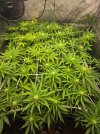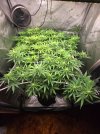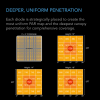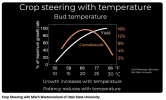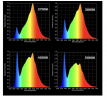I see no indication of anything other than a well nourished cannabis grow. You've also pretty much grown out the canopy to cover the entire grow space. That's good to see—no photon is wasted.
The Uni-T is sufficiently accurate for most growers and, at 826µmol, you're about 200µmol below where I would run the grow.
Re. the accuracy of the Uni-T—it's "calibrated" to 5%± per their literature and I have no reason to not believe that. I tested the Uni-T in 11/23 and here are the results:
View attachment 5469411
I compared the results from the Uni-T against my MQ-500 (calibrated) and determined the "conversion factor" for the light to be 0.0145 which seems to be "about right". "about right" is as close as I could get because I don't have much info on the XS-1500 spectrum but it's got more blue in it than the "average" white LED so 0.0145 is about right.
Is 0.0145
correct? It's close enough. As I see it, the primary goal of measuring PPFD is to get some idea of how much light is falling on the canopy and then let your plants tell you how much light they can use. The most obvious signs of a plant that is getting too much light are that the edges of the leaves will curl inward ("canoeing" or "tacoing") and in some cases leaves will rotate around the petiole in the same way that a Venetian blind opens and closes.
If you're fat 867 now, increase you input wattage by ~10% or lower the light by about 2". That will get you over 900µmol and that's a good number for cannabis.
My practice is to increase light levels in the morning and check the plants at 30 minutes and 60 minutes. If the new light levels are at or above the "light saturation point", the plants will let you know. Cannabis reacts very quickly so two checks, 30 and 60, should do the trick.
In ambient CO2, cannabis will thrive at 1kµmol, assuming that light is the limiting factor. If your grow is in good shape (temp+RH/VPD, adequate nutrient levels, properly watered) you should be able to put that much light on the plant.
The PPFD map for your light is shown here. As expected, the higher the light is above the canopy, the more even the lightcast. In a 3' x 3', there's enough light being generated that you can get ~1k in the center of the grow and still get good light around the edges.
View attachment 5469410
At this point in the grow, your plants have completed most of the "building" process so it's about time to reduce ambient temperatures so that the tops of the buds are <78°. The graphic below is based on the research that Mitch Westmoreland did for his PhD (he was a student under Bruce Bugbee).
He released an excellent video on cannabis about 18 months ago. Check for it on YouTube. It's about an hour long and full of excellent information about getting the most out of a cannabis grow.
View attachment 5469412


